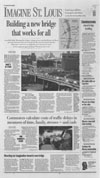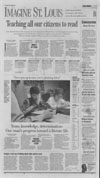Summer 1999
Shining a Light in Dark Corners
By Pat Ford
Pew Center

Imagine the St. Louis Post-Dispatch inviting readers to join in serious conversations about important public issues in a section every Sunday. The section would have to include background on the issue and opportunities to join the discussion.
There you have the basic ingredients of “Imagine St. Louis,” the Post-Dispatch’s redesign of its Sunday news analysis section, launched April 11.
“We hope this new section will help all of metropolitan St. Louis engage in serious discussion of our most pressing priorities,” said editor Cole Campbell in a signed column in the inaugural edition. “We hope these will become continuing conversations because what you say will affect how we explore each issue. Over time, we hope all this talk and news coverage will set the stage for action.”
It is a new way for the Post-Dispatch to reach out to readers. But it is an approach Campbell has pioneered, creating similar features at The Virginian Pilot before moving to St. Louis in 1997.
“Imagine St. Louis” topics have covered plans for a new bridge over the Mississippi, the area’s arts community, and immigration.

The April 11 section focused on literacy and included a number of features that section editor Robert W. Duffy says will be present in every “Imagine St. Louis.”
A mainbar at the top of the page defined the problem and its scope. Below was a feature about one man’s struggle to learn to read. Down the right-hand side, a column called “Conversations” suggested ways readers could respond to the information. The Post-Dispatch phone and fax numbers, e-mail and mailing addresses were top-most. Reader comments and letters followed, usually addressing the previous week’s topic.
The “Conversations” column also announced radio and TV call-in talk shows focusing on literacy and two St. Louis area organizations hosting speakers on the subject. Duffy helped arrange for the speakers and worked with the broadcasters to schedule shows on the topic. He says local stations are attracted by the cross-promotion the section offers.
Inside, the information was broken down into bar graphs and pie charts and what Duffy calls the “issues map.” The “map” showed how four key questions about literacy might be answered from four different perspectives. For instance, people answered the question “What should be done” about illiteracy quite differently, depending on whether they believe the power to read is a personal responsibility, a school obligation, a societal duty or simply beyond the ability of some to acquire.
“This,” says Duffy, “is where actual light bulbs came on for people.” He says readers confessed they’d never looked at the issue from different perspectives before and actually came away with a better understanding of other viewpoints.
The inside pages also included a bibliography of where to get more information, a list of decisionmakers and policy leaders, labeled “Who Calls the Shots,” and a directory of agencies “to get or give help.”
The Literacy Council of Greater St. Louis, which was listed, says it received a “huge increase” in calls after the section ran, some seeking help but even more offering to volunteer.
The Council’s education coordinator Tammy Bigler says the response, at times 10 calls a day, surprised her. “We didn’t expect it to move people as it did,” says Bigler. “I figured it would strike an interest but I certainly didn’t expect all the calls we’ve gotten.”
The Council’s executive director Michael Guynn says the figures – which suggested that about a third of St. Louis adults were functionally illiterate – “kind of shocked people.” The section has stimulated what he called “water-cooler type conversation.”
“If there is such a thing as interactive journalism,” says Guynn, “that’s what this is; something you can actually use other than for wrapping fish.”
Donna Burke, director of Parkway Area Adult Basic Education, another service provider, says she especially enjoyed the letters that appeared the following week. She even quoted from them for a proposal she was writing. “I think it’s just the kind of mindset we need in St. Louis to open ourselves up to how we can work together as a community,” she says.
That is just the sort of reaction Post-Dispatch editors were hoping for in designing the section, says Duffy. “This region is so fragmented,” he says, “unless some strong institution comes to the fore to talk to people, to find common cause, acknowledge a common destiny and make real strong structural improvements in the region, we’ll be in trouble in the next century.”
Duffy thinks it’s natural for the Post-Dispatch to play that role. “This fulfills in rich and glorious detail Joseph Pulitzer’s call to ‘never be satisfied with merely printing the news.'”
Though it may seem that way to Duffy now, that is not the belief that prevailed at the paper before Campbell arrived. Former Editor Bill Woo was an avowed skeptic about including readers in the newspaper’s pages. Indeed, he often used Pulitzer’s platform, which also admonishes “always be drastically independent,” as a rationale for rejecting the tools of civic journalism that “Imagine St. Louis” draws on so heavily.
According to reporters who did not wish to be identified, the Post-Dispatch staff was wary of Campbell’s appointment for that very reason, fearing he would take them down a path Woo had led them to distrust. But, they say, Campbell acted slowly and deliberately in making changes.
There is still some staff skepticism about “Imagine St. Louis,” acknowledges Duffy. But, he says, there are also converts. “This is a great showplace for reporters’ work,” he says, “a good place to show their authority on their beat.
“There are a number of ways to shine a light in a dark corner and this is one of them. It’s very exciting and it’s enriching for the community. The people responding to this feel like there’s finally a way to have a great big civic conversation.”
